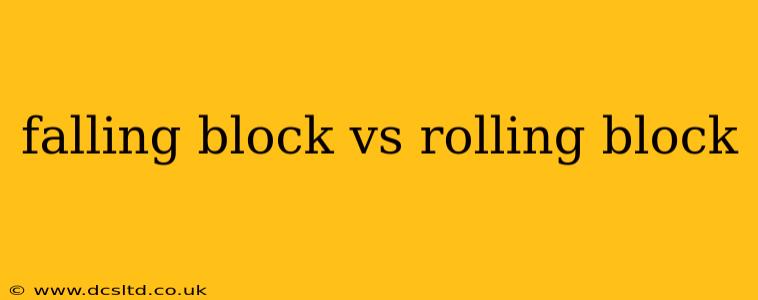The terms "falling block" and "rolling block" refer to distinct mechanisms found in firearms, particularly rifles. Understanding their differences is crucial for appreciating the history, mechanics, and relative advantages of each design. This article dives deep into the core distinctions between these action types, addressing common questions and exploring their impact on firearm functionality.
What is a Falling Block Action?
A falling block action is a type of firearm action where a solid block of metal hinges downward to expose the breech, allowing for loading and unloading of ammunition. This block typically forms part of the receiver, providing a robust and relatively simple mechanism. When the action is closed, the block is locked firmly against the breech face, ensuring safe and reliable firing. The simplicity of the design contributes to its durability and ease of maintenance. Many early firearms, especially single-shot rifles, utilized falling block actions.
What is a Rolling Block Action?
In contrast, a rolling block action features a block that rotates on a pivot point to open and close the breech. The block is typically much smaller and lighter than in a falling block action, often sliding along a track or within a channel. This design allows for a more compact action and can be adapted for various cartridge types, unlike the typically fixed-caliber nature of many falling block designs. The rolling block mechanism, known for its strength and relative simplicity, saw widespread use in military rifles during the late 19th century.
How Do Falling Block and Rolling Block Actions Differ?
The core difference lies in the method of opening and closing the breech. A falling block hinges downwards, while a rolling block rotates. This seemingly small variation leads to several key distinctions:
- Simplicity of Mechanism: Falling block actions are generally simpler to manufacture and maintain. Their robust construction often leads to longer lifespans with less wear and tear.
- Compactness: Rolling block actions tend to be more compact, making them suitable for smaller rifles or those with shorter overall lengths.
- Cartridge Flexibility: Rolling block actions, in many cases, are more readily adaptable to different cartridge types. Falling block actions often operate with a fixed caliber.
- Strength and Reliability: Both mechanisms are generally reliable, but the rolling block, with its more controlled locking mechanism, might be considered slightly more robust under high-pressure conditions.
- Ease of Use: Both actions require a degree of dexterity. Some users might find the rotational motion of a rolling block action slightly more intuitive.
What are the Advantages and Disadvantages of Each Action Type?
Falling Block Action:
Advantages:
- Simple design, easy to manufacture and maintain.
- Durable and reliable.
- Strong locking mechanism.
Disadvantages:
- Typically limited to a single caliber.
- Can be larger and heavier than rolling block actions.
Rolling Block Action:
Advantages:
- Compact design.
- Can handle multiple cartridge types (depending on the specific firearm).
- Strong and reliable.
Disadvantages:
- Slightly more complex design than falling block actions.
- Can be more complex to maintain if intricate.
What Type of Ammunition Do Falling Block and Rolling Block Actions Use?
The type of ammunition used depends not on the action type itself, but rather the specific firearm design. Falling block actions are often associated with older, single-shot rifles of varying calibers, while rolling block actions were used in both single-shot and magazine-fed rifles with a wider range of cartridges. It’s crucial to check the specific specifications of an individual firearm rather than making generalizations based solely on the action type.
Which Action Type is Better?
There's no single "better" action type; the ideal choice depends entirely on the application and priorities of the user. For simplicity, durability, and potentially lower cost, a falling block action might be preferred. For compactness and adaptability, a rolling block action could be more desirable.
This discussion highlights the nuances of firearm mechanisms, showcasing how seemingly minor differences in design can have significant implications for functionality, reliability, and overall user experience. Understanding these distinctions is critical for anyone interested in firearms history, mechanics, or collection.
